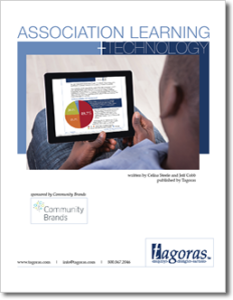Association Learning + Technology

The world of continuing education and professional development has changed dramatically in the past few years. To meet member needs and stay out in front of the competition, you need to arm yourself with real data targeted to help you grow your programs.
Association Learning + Technology provides the most comprehensive insights currently available on the use of technology to enhance and enable education in the association sector. It is designed for association leaders who want to be fully informed as they make strategic decisions about launching or growing new education initiatives.
The report is based on a survey of more than 200 membership organizations. In addition to providing essential data and analysis, the report’s authors, Jeff Cobb and Celisa Steele offer valuable predictions as well as a range of questions to help organizations with setting strategy.
With recent versions, we have started making this report available at no charge to anyone who subscribes to the Leading Learning monthly e-newsletter (also free). To get the latest version of Association Learning + Technology, use the button below to sign up for the newsletter. It’s free and of high value, and you’ll also get other great resources. To subscribe, simply click the button below and then look for a welcome e-mail in your inbox.
Report Highlights
Here are a few highlights from the Association Learning + Technology report:
- Of the 203 qualifying responses to the survey that serves as the basis for the report, 92.6 percent are from individuals whose organizations currently offer technology-enabled or technology-enhanced learning. An additional 6.9 percent of respondents indicate they plan to start using technology to enable or enhance learning in the coming 12 months, leaving only 0.5 percent not using technology for learning and with no plans to start in the coming year. There’s significant use of technology to deliver and enhance learning even among smaller organizations. Nearly half (47.9 percent) of organizations that reported using technology for learning have annual budgets of $5 million or less, and 13.0 percent have budgets of $1 million or less.
- The most popular type of technology-enabled or technology-enhanced learning is the all but ubiquitous Webinar. Recorded Webinars and Webcasts are offered by 91.4 percent of respondents currently using technology for learning, and 90.0 percent offer real-time ones. Self-paced online courses, tutorials, or presentations come in third (offered by 72.8 percent) and are the only other offering of the five types we asked about to garner a majority. Facilitated learning is last, offered by only 33.9 percent.
- We also asked specifically about five emerging types of learning: massive open online courses (MOOCs), flipped classes, gamified learning, microcredentials (like digital badges), and microlearning. Microlearning—a recent addition to the survey—shows the highest rate of adoption 30.1 percent, with an additional 36.1 percent reporting plans for the coming year. Digital badges are offered by 14.8 percent and, like microlearning, seem poised for significant growth with a quarter (25.3 percent) of respondents reporting plans to add digital badges in the year ahead. Flipped classes are offered by 13.3 percent of respondents, and gamified learning and MOOCs are currently offered by under a tenth of respondents using technology for learning.
- Some 49.7 percent of respondents currently using technology for learning provide a mobile version of at least some of their content. Add in those planning to offer a mobile version in the next 12 months (25.7 percent), and it’s clear m-learning is becoming a staple among associations.
- This edition of the report addresses, for the first time, whether organizations have a formal, documented strategy for their learning and education business (as opposed to a strategy focused on the use of technology for learning), and a majority (57.1 percent) don’t, with another 5.1 unsure if they have one. Two-thirds (66.0 percent) of respondents’ organization doesn’t have a formal, documented product development process that includes its technology-enabled and technology-enhanced education products, and 59.7 percent don’t have a formal, documented process for setting prices that includes their technology-enabled and technology-enhanced education products.
- When asked if they’re satisfied overall with their current technology-enabled and technology-enhanced learning initiatives, 69.0 percent of associations said they were either somewhat (56.5 percent) or very (12.5 percent) satisfied. While 58.6 percent of respondents rate themselves as somewhat successful with their use of technology for learning, a more modest 18.5 percent characterize their use of technology for learning as very successful.
That’s just a small sampling. Subscribe today to get the full report!
Thanks to Our Sponsor
We’re grateful to Community Brands for sponsoring Association Learning + Technology.
